Earlier in this chapter we stated that if a function has a local extremum at a point , then must be a critical point of f. However, a function is not guaranteed to have a local extremum at a critical point. For example, has a critical point at since is zero at , but does not have a local extremum at . Using the results from the previous section, we are now able to determine whether a critical point of a function actually corresponds to a local extreme value. In this section, we also see how the second derivative provides information about the shape of a graph by describing whether the graph of a function curves upward or curves downward.
The First Derivative Test
Corollary of the Mean Value Theorem showed that if the derivative of a function is positive over an interval then the function is increasing over . On the other hand, if the derivative of the function is negative over an interval , then the function is decreasing over as shown in the following figure.
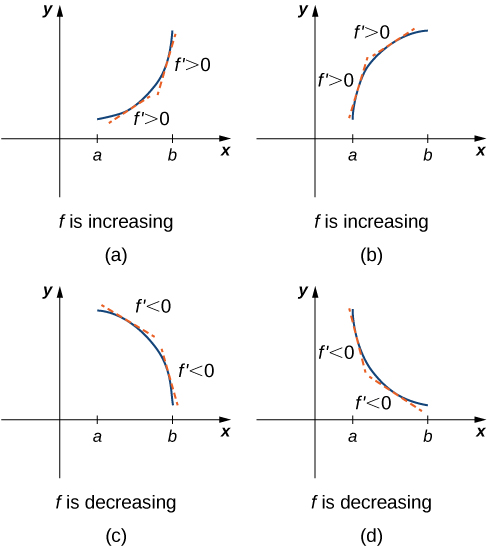
Figure : Both functions are increasing over the interval . At each point , the derivative . Both functions are decreasing over the interval . At each point , the derivative
A continuous function has a local maximum at point if and only if switches from increasing to decreasing at point . Similarly, has a local minimum at if and only if switches from decreasing to increasing at . If is a continuous function over an interval containing and differentiable over , except possibly at , the only way can switch from increasing to decreasing (or vice versa) at point is if changes sign as increases through . If is differentiable at , the only way that . can change sign as increases through is if . Therefore, for a function that is continuous over an interval containing and differentiable over , except possibly at , the only way can switch from increasing to decreasing (or vice versa) is if or is undefined. Consequently, to locate local extrema for a function , we look for points in the domain of such that or is undefined. Recall that such points are called critical points of .
Note that need not have a local extrema at a critical point. The critical points are candidates for local extrema only. In Figure, we show that if a continuous function has a local extremum, it must occur at a critical point, but a function may not have a local extremum at a critical point. We show that if has a local extremum at a critical point, then the sign of switches as increases through that point.
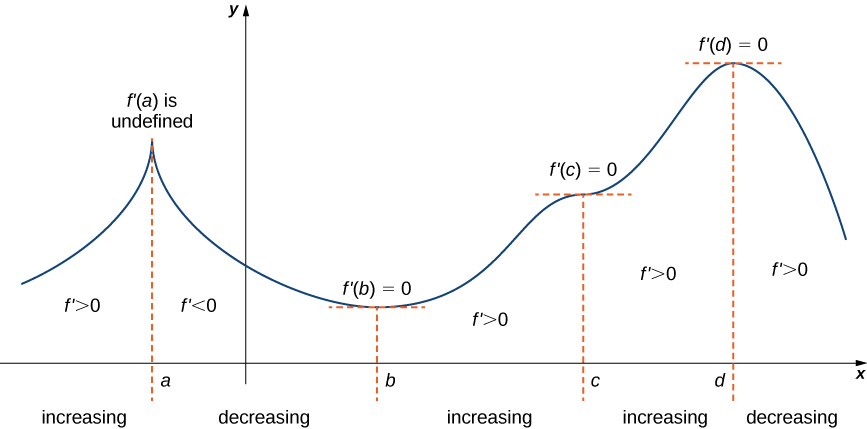
Figure : The function has four critical points: ,and . The function has local maxima at and , and a local minimum at . The function does not have a local extremum at . The sign of changes at all local extrema.
Using Figure, we summarize the main results regarding local extrema.
- If a continuous function has a local extremum, it must occur at a critical point .
- The function has a local extremum at the critical point if and only if the derivative switches sign as increases through .
- Therefore, to test whether a function has a local extremum at a critical point , we must determine the sign of to the left and right of .
This result is known as the first derivative test.
First Derivative Test
Suppose that is a continuous function over an interval containing a critical point . If is differentiable over , except possibly at point , then satisfies one of the following descriptions:
- If changes sign from positive when to negative when , then is a local maximum of .
- If changes sign from negative when to positive when , then is a local minimum of .
- If has the same sign for and , then is neither a local maximum nor a local minimum of
Now let’s look at how to use this strategy to locate all local extrema for particular functions.
Example : Using the First Derivative Test to Find Local Extrema
Use the first derivative test to find the location of all local extrema for Use a graphing utility to confirm your results.
Solution
Step 1. The derivative is To find the critical points, we need to find where Factoring the polynomial, we conclude that the critical points must satisfy
Therefore, the critical points are x Now divide the interval into the smaller intervals and
Step 2. Since is a continuous function, to determine the sign of over each subinterval, it suffices to choose a point over each of the intervals and and determine the sign of at each of these points. For example, let’s choose and as test points.
| Interval |
Test Point |
Sign of at Test Point |
Conclusion |
|
|
(+)(−)(−)=+ |
is increasing. |
|
|
(+)(−)(+)=− |
is decreasing. |
|
|
(+)(+)(+)=+ |
is increasing. |
Step 3. Since switches sign from positive to negative as increases through has a local maximum at . Since switches sign from negative to positive as increases through has a local minimum at . These analytical results agree with the following graph.
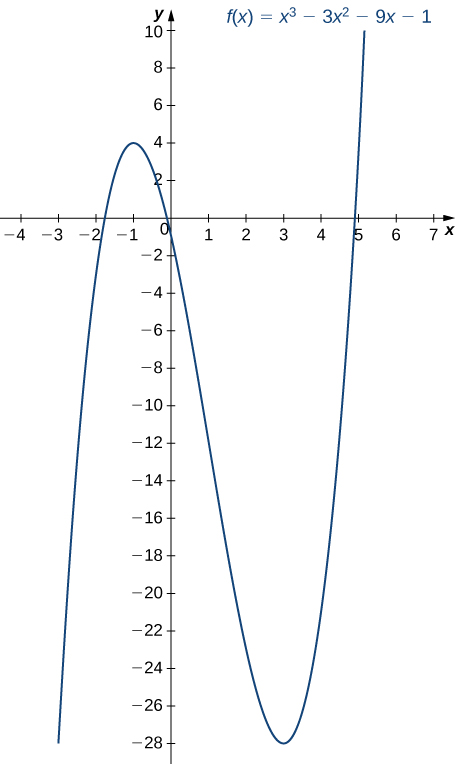
Figure : The function f has a maximum at and a minimum at
 Exercise
Exercise
Use the first derivative test to locate all local extrema for
- Hint
-
Find all critical points of and determine the signs of over particular intervals determined by the critical points.
- Answer
-
has a local minimum at and a local maximum at .
Example : Using the First Derivative Test
Use the first derivative test to find the location of all local extrema for Use a graphing utility to confirm your results.
Solution
Step 1. The derivative is
The derivative when Therefore, at . The derivative is undefined at Therefore, we have three critical points: and . Consequently, divide the interval into the smaller intervals and .
Step 2: Since is continuous over each subinterval, it suffices to choose a test point in each of the intervals from step 1 and determine the sign of at each of these points. The points are test points for these intervals.
| Interval |
Test Point |
Sign of at Test Point |
Conclusion |
|
|
|
is decreasing. |
|
|
|
is increasing. |
|
|
|
is increasing. |
|
|
|
is decreasing. |
Step 3: Since is decreasing over the interval and increasing over the interval has a local minimum at . Since is increasing over the interval and the interval , f does not have a local extremum at . Since is increasing over the interval and decreasing over the interval has a local maximum at . The analytical results agree with the following graph.
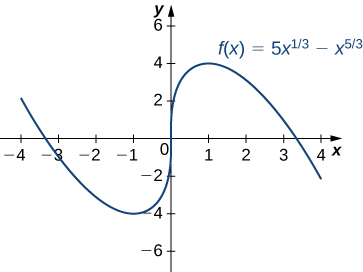
Figure : The function f has a local minimum at and a local maximum at
 Exercise
Exercise
Use the first derivative test to find all local extrema for .
- Hint
-
The only critical point of is
- Answer
-
has no local extrema because does not change sign at .
Concavity and Points of Inflection
We now know how to determine where a function is increasing or decreasing. However, there is another issue to consider regarding the shape of the graph of a function. If the graph curves, does it curve upward or curve downward? This notion is called the concavity of the function.
Figure(a) shows a function with a graph that curves upward. As increases, the slope of the tangent line increases. Thus, since the derivative increases as increases, is an increasing function. We say this function is concave up. Figure(b) shows a function that curves downward. As increases, the slope of the tangent line decreases. Since the derivative decreases as increases, is a decreasing function. We say this function is concave down.
Definition: concavity test
Let be a function that is differentiable over an open interval . If is increasing over , we say is concave up over . If is decreasing over , we say is concave down over .
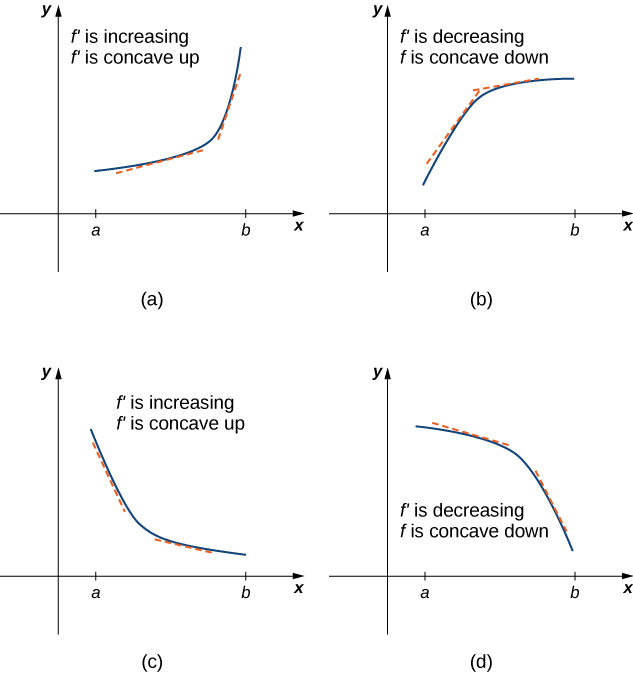
Figure : (a), (c) Since is increasing over the interval , we say is concave up over Since is decreasing over the interval , we say is concave down over
In general, without having the graph of a function how can we determine its concavity? By definition, a function is concave up if is increasing. From Corollary , we know that if is a differentiable function, then is increasing if its derivative . Therefore, a function that is twice differentiable is concave up when . Similarly, a function is concave down if is decreasing. We know that a differentiable function is decreasing if its derivative . Therefore, a twice-differentiable function is concave down when . Applying this logic is known as the concavity test.
Test for Concavity
Let be a function that is twice differentiable over an interval .
- If for all , then is concave up over
- If for all then is concave down over .
We conclude that we can determine the concavity of a function by looking at the second derivative of . In addition, we observe that a function can switch concavity (Figure). However, a continuous function can switch concavity only at a point if or is undefined. Consequently, to determine the intervals where a function is concave up and concave down, we look for those values of where or is undefined. When we have determined these points, we divide the domain of into smaller intervals and determine the sign of ' over each of these smaller intervals. If changes sign as we pass through a point , then changes concavity. It is important to remember that a function may not change concavity at a point even if or is undefined. If, however, does change concavity at a point a and is continuous at , we say the point is an inflection point of .
Definition: inflection point
If is continuous at and changes concavity at , the point is an inflection point of .
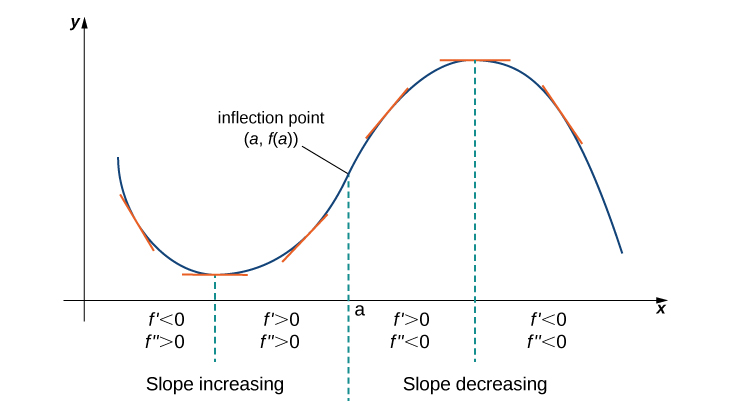
Figure : Since for , the function is concave up over the interval . Since for , the function is concave down over the interval . The point is an inflection point of .
Example : Testing for Concavity
For the function determine all intervals where is concave up and all intervals where is concave down. List all inflection points for . Use a graphing utility to confirm your results.
Solution
To determine concavity, we need to find the second derivative The first derivative is so the second derivative is If the function changes concavity, it occurs either when or is undefined. Since is defined for all real numbers , we need only find where . Solving the equation , we see that is the only place where could change concavity. We now test points over the intervals and to determine the concavity of . The points and are test points for these intervals.
| Interval |
Test Point |
Sign of at Test Point |
Conclusion |
|
|
− |
is concave down |
|
|
+ |
is concave up |
We conclude that is concave down over the interval and concave up over the interval . Since changes concavity at , the point is an inflection point. Figure confirms the analytical results.
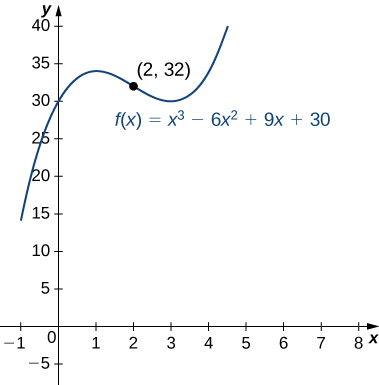
Figure : The given function has a point of inflection at where the graph changes concavity.
 Exercise
Exercise
For , find all intervals where is concave up and all intervals where is concave down.
- Hint
-
Find where
- Answer
-
is concave up over the interval and concave down over the interval
We now summarize, in Table, the information that the first and second derivatives of a function provide about the graph of , and illustrate this information in Figure.
What Derivatives Tell Us about Graphs
| Sign of |
Sign of |
Is increasing or decreasing? |
Concavity |
| Positive |
Positive |
Increasing |
Concave up |
| Positive |
Negative |
Increasing |
Concave down |
| Negative |
Positive |
Decreasing |
Concave up |
| Negative |
Negative |
Decreasing |
Concave sown |
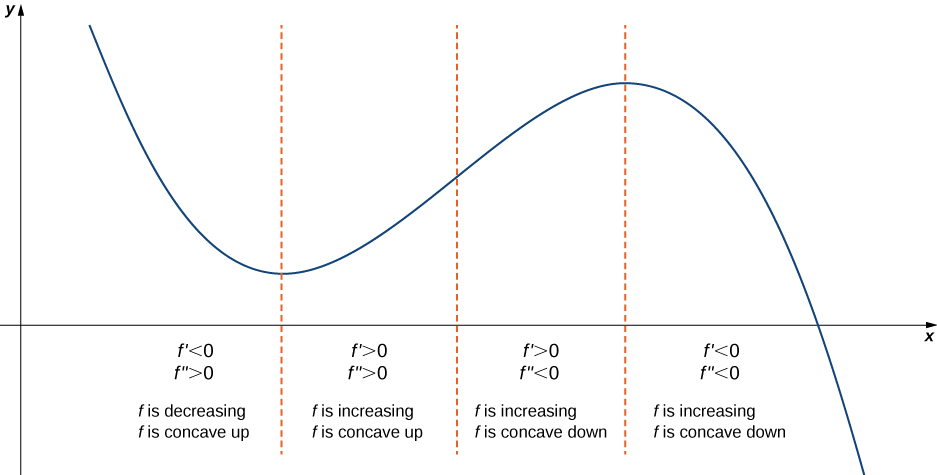
Figure : Consider a twice-differentiable over an open interval . If for all , the function is increasing over . If for all , the function is decreasing over . If for all , the function is concave up. If for all , the function is concave down on .
The Second Derivative Test
The first derivative test provides an analytical tool for finding local extrema, but the second derivative can also be used to locate extreme values. Using the second derivative can sometimes be a simpler method than using the first derivative.
We know that if a continuous function has a local extrema, it must occur at a critical point. However, a function need not have a local extrema at a critical point. Here we examine how the second derivative test can be used to determine whether a function has a local extremum at a critical point. Let be a twice-differentiable function such that and is continuous over an open interval containing . Suppose . Since is continuous over for all (Figure). Then, by Corollary is a decreasing function over . Since , we conclude that for all if and if . Therefore, by the first derivative test, has a local maximum at . On the other hand, suppose there exists a point such that but . Since is continuous over an open interval containing , then for all (Figure). Then, by Corollary is an increasing function over . Since , we conclude that for all , if and if . Therefore, by the first derivative test, has a local minimum at
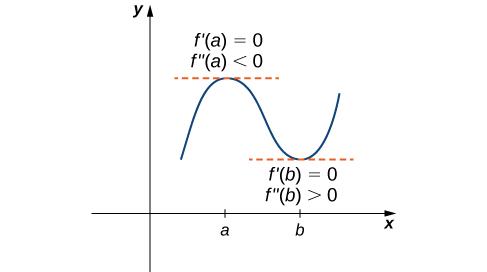
Figure : Consider a twice-differentiable function such that is continuous. Since and , there is an interval containing such that for all in , is increasing if and is decreasing if . As a result, has a local maximum at . Since and , there is an interval containing such that for all in , is decreasing if and is increasing if . As a result, has a local minimum at .
Second Derivative Test
Suppose is continuous over an interval containing .
- If , then has a local minimum at .
- If , then has a local maximum at .
- If then the test is inconclusive.
Note that for case iii. when , then may have a local maximum, local minimum, or neither at . For example, the functions and all have critical points at . In each case, the second derivative is zero at . However, the function has a local minimum at whereas the function has a local maximum at , and the function does not have a local extremum at .
Let’s now look at how to use the second derivative test to determine whether has a local maximum or local minimum at a critical point c where
Example : Using the Second Derivative Test
Use the second derivative to find the location of all local extrema for
Solution
apply the second derivative test, we first need to find critical points where . The derivative is . Therefore, when \(x=0,±\sqrt{3}\).
To determine whether has a local extrema at any of these points, we need to evaluate the sign of at these points. The second derivative is
In the following table, we evaluate the second derivative at each of the critical points and use the second derivative test to determine whether has a local maximum or local minimum at any of these points.
|
|
Conclusion |
|
|
Local maximum |
|
|
Second derivative test is inconclusive |
|
|
Local minimum |
By the second derivative test, we conclude that has a local maximum at and has a local minimum at . The second derivative test is inconclusive at . To determine whether has a local extrema at we apply the first derivative test. To evaluate the sign of for and , let and be the two test points. Since and , we conclude that is decreasing on both intervals and, therefore, does not have a local extrema at as shown in the following graph.
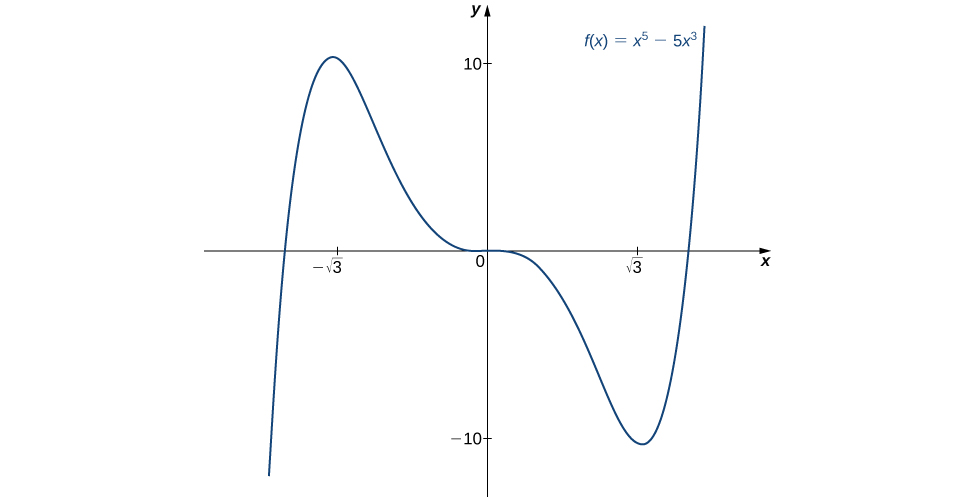
Figure :The function has a local maximum at and a local minimum at
 Exercise
Exercise
Consider the function . The points satisfy . Use the second derivative test to determine whether has a local maximum or local minimum at those points.
- Hint
-
- Answer
-
has a local maximum at and a local minimum at .
We have now developed the tools we need to determine where a function is increasing and decreasing, as well as acquired an understanding of the basic shape of the graph. In the next section we discuss what happens to a function as At that point, we have enough tools to provide accurate graphs of a large variety of functions.
Key Concepts
- If is a critical point of and for and for , then has a local maximum at .
- If is a critical point of and for and for then has a local minimum at .
- If over an interval , then is concave up over .
- If over an interval , then is concave down over .
- If and , then has a local minimum at .
- If and , then has a local maximum at .
- If and , then evaluate at a test point to the left of and a test point to the right of , to determine whether has a local extremum at .
Glossary
- concave down
- if is differentiable over an interval and is decreasing over , then is concave down over
- concave up
- if is differentiable over an interval and is increasing over , then is concave up over
- concavity
- the upward or downward curve of the graph of a function
- concavity test
- suppose is twice differentiable over an interval ; if over , then is concave up over ; if over , then is concave down over
- first derivative test
- let be a continuous function over an interval containing a critical point such that is differentiable over except possibly at ; if changes sign from positive to negative as increases through , then has a local maximum at ; if changes sign from negative to positive as increases through , then has a local minimum at ; if does not change sign as increases through , then f does not have a local extremum at
- inflection point
- if is continuous at and changes concavity at , the point is an inflection point of
- second derivative test
- suppose and ' is continuous over an interval containing ; if , then has a local minimum at ; if , then has a local maximum at ; if , then the test is inconclusive



![]() Exercise
Exercise 
![]() Exercise
Exercise 


![]() Exercise
Exercise 


![]() Exercise
Exercise 

